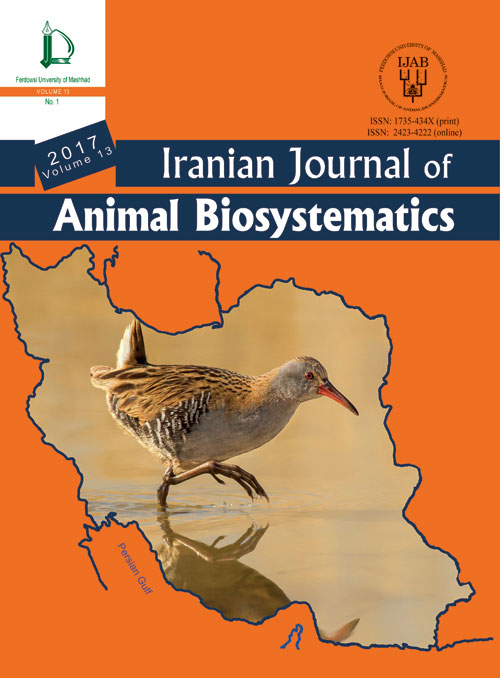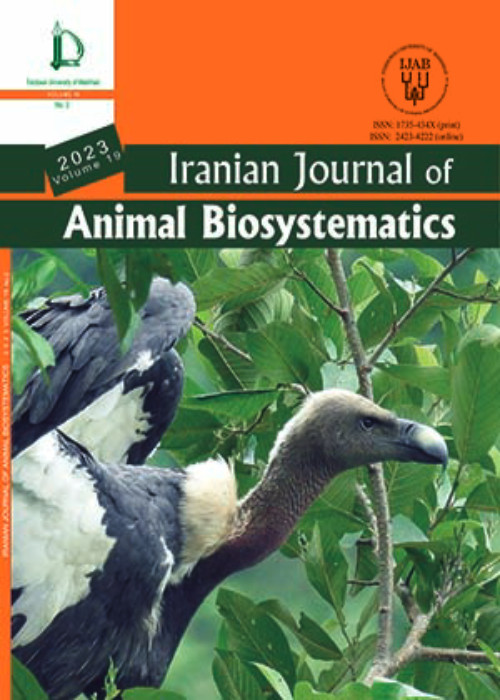فهرست مطالب

Iranian journal of animal biosystematics
Volume:13 Issue: 1, Winter-Spring 2017
- تاریخ انتشار: 1396/03/30
- تعداد عناوین: 11
-
-
Page 1A new cephalobid nematode, Trithornus aquatica gen. n. sp. n. has been described and illustrated. The new genus can be distinguished by the unique shape of its labial probolae, consisting of swollen labial shaft and a trifurcated apical section. The cephalic probolae is triangular in shape. Cuticle is transversely annulated, lateral field with five incisors, outer ones being undulate. The stoma comprises of cheilostom with granular rhabdia, gymnostom narrower than cheilostom and stegostom. Stegostome can be differentiated into three parts meta, meso and telo. A tooth is present on mesostegostome. Females have cephaloboid type of reproductive system. Tail is elongate conoid with a pointed tip. Males were not found. The newly described genus closely resembles Acrobeles Linstow, 1877, Chiloplacus Thorne, 1937 and Cervidellus Thorne, 1937 in having similar stoma, furcated labial probolae, simple cuticle and cephaloboid type of female gonad with a post uterine sac. But, is clearly distinguishable by the related genera on the basis of the shape of labial probolae and the presence of outer undulated lateral lines. A dichotomous key to the identification of the genus has also been provided.Keywords: Aquatic, Cephalobidae, Cephalobina, Trithornus, taxonomy, India
-
Page 9Heteroptera as one of the most important insect orders with a significant ecological role is still scarcely known faunistically in several areas of Iran. In order to contribute to the knowledge of the Iranian Heteroptera fauna, a survey was carried out to provide detailed information on the distribution of true bugs in South Khorasan province (Ghaen and vicinity). Samples were collected using aspirator and sweeping net by irregular patterns. In total, 136 specimens were collected and identified. They consisted of 20 species and subspecies belonging to 15 genera of 7 families. Among the collected specimens, 19 taxa were new for South Khorasan fauna including Orius albidipennis (Reuter) (Anthocoridae); Henestaris halophilus (Burmeister), Geocoris pallidipennis (Costa) (Lygaeidae); Lygus gemellatus (Herrich-Schäffer), Deraeocoris punctulatus (Fallén), Adelphocoris lineolatus (Goeze), Creontiades pallidus (Rambur), Stenodema calcarata (Fallén), Orthops campestris (Linnaeus), O. pilosulus (Jakovlev) (Miridae); Nabis palifera (Seidenstűcker), N. pseudoferus orientarius (Remane), N. punctatus (A. Costa), N. capsiformis (Germar) (Nabidae); Camptopus lateralis (Germar) (Alydidae); Coranus angulatus (Stål) (Reduviidae); Brachycarenus tigrinus (Schilling), Liorhyssus hyalinus (Fabricius) and Stictopleurus abutilon (Rossi) (Rhopalidae). S. trispinosa (Reuter) was a new record for the fauna of Iran. Among the collected specimens, 7 species were predators and 13 species were plant feeders. Regarding the rare faunistic studies of Heteroptera in South Khorasan province and concerning the variety of geographical elements in this area, it is expected that there are still a large number of true bugs species remain to be discovered in various parts of this province.Keywords: Alfalfa, Heteroptera, South Khorasan, new record
-
Page 23Sexual dimorphism in 45 ( 27 males, 18 females ) specimens of Trapelus ruderatus ruderatus was studied in specimens collected from three localities: Bahr AL-Najaf, AL-Najaf Province; Albedhan village, Said dekheel county, Dhi-Qar Province and Khor AL-Zubair, AL-Basra Province, southern Iraq. Of 23 studied characters in males and females, statistical analysis using SPSS software version 20.00 showed significant differences in 11, out of 23, characters (male-biased): SVL, TL, HW, HH, DCC, RP, NP, CT, VL, AbnL and LHS. In comparison to females, males had different color pattern, much darker and more developed gular folds and darker ventral regions.Keywords: Agamidae, Trapelus ruderatus ruderatus, Sexual dimorphism, Southern Iraq
-
Page 33Pristionchus stercoraris sp. n. and Tylopharynx foetida (Bütschli, 1874) Goffart, 1930 of the suborder Diplogastrina are described and illustrated in detail. Both the species were isolated from farmyard manure collected from Baramulla, Jammu & Kashmir, India. P. stercoraris sp. n. is characterized by faint annulations on cuticle, steno as well as eurystomatous types of stoma, thin-walled cheilostom, long elongate cardia, slender spicules with slightly anteriorly curved distal tip, a boat-shaped gubernaculum with a medial dorsal convex; proximally with an anteriorly directed needle-like extension and distally with a sleeve and eight pairs of genital papillae. Measurements and descriptions of our specimens of T. foetida agree well with that of Bütschli (1874). However, slight differences were observed in the length of stoma, tail, anal body diameter, anterior pharynx, and in the position of excretory pore. No species of both Pristionchus and Tylopharynx have so far been reported from India.Keywords: Descriptions, farmyard manure, first report, new species, Pristionchus, taxonomy, Tylopharynx
-
Page 41Present paper reports four species of porcelain crabs in three genera from the Gujarat coast, India. Ancylocheles gravelei (Sankolli, 1963), Pisidia dehaanii (Krauss, 1843), P. gordoni (Johnson, 1970) and Polyonyx hendersoni Southwell, 1909 are reported from the Gujarat coast for the first time. Twelve porcellanid species are known from the Gujarat coast, including four species reported in this paper.Keywords: Crustacea, Anomura, Porcellanidae, distribution, Gujarat
-
Page 53The mtDNA data presently being used for estimating biodiversity is not sufficient for evaluating the Motacilla alba complex species status. Because there is a lack of congruence between morphological and mtDNA data, there are debates about the best approach to use. In this study, we utilize niche modelling to study nine taxa of M. alba complex. Using eight bioclimatic- environmental layers, altitude, and slope MaxEnt modeling was applied to predict distributions. A total of 9087 input points for presence of species were also used. Results showed nine distinct ecological boundaries based on MaxEnt and ecological niche modeling (ENM) tools. The results provide some ecological variables for determining the ecological requirements and distribution patterns of the white wagtail species complex in the Palearctic region.Keywords: niche modeling, Motacilla alba, complex species, ecological boundaries
-
Page 67During herpetological fieldwork from April 2013 to March 2014 on the herpetofauna of the counties of Saravan, Sib and Suran, Zaboli, Sarbaz, and Chabahar in south east of Sistan and Baluchestan Province, SoutheasternIran a total of 97 specimens of lizards belonging to 19 species and five subspecies, 16 genera, and six families were collected and identified as follows: Calotes versicolor, Laudakia nupta nupta, L. n. fusca, Phrynocephalus scutellatus, Trapelus agilis agilis (Agamidae); Agamura persica, Bunopus tuberculatus, Cyrtopodion scabrum (Gekkonidae); Acanthodactylus blanfordii, A. micropholis, Eremias fasciata, E. persica , Mesalina watsonana, Ophisops elegans (Lacertidae); Ablepharus pannonicus, Eumeces schneiderii zarudnyi, Ophiomorus brevipes, O. tridactylus (Scincidae); Uromastyx asmussi (Uromastycidae); and Varanus griseus caspius (Varanidae). The most diverse families of the present collection are the Lacertidae with six species, followed by Agamidae and Scincidae each with four species. Detailed information of each lizard species was also provided.Keywords: Herpetofauna, species, lizards, distribution, Sistan, Baluchestan Province, Iran
-
Page 77Daphnia a wide spread member of Cladocera live in different aquatic environments ranging from hypersaline swamps to freshwater lakes, lagoons, streams and rivers. To improve our knowledge in the diversity of the genus Daphnia in Iran, and promoting its biogeographical information in the region, an investigation on the morphology and identification of the Iranian species of the genus was carried out during the spring of 2013 and 2014. The Southern Caspian Sea Basin (SCSB) and Urmia Lake Basin (ULB) Daphnia fauna has been studied based on historical literature records and new collections. Zooplanktons were sampled from 70 randomly chosen localities across ca. 2500 km wide longitudinal gradient in the SCSB and ULB basins including both permanent habitats (lakes and reservoirs), and small temporary water bodies (ponds and lagoons), both freshwater and saline. In the samples, 34 populations were identified based on the morphological and scanning electron microscopy (SEM) approaches. Cladistic analysis of Iranian species of genus Daphnia, based on 64 morphological characters obtained from the literature, confirmed the traditionally basic division of the genus into two subgenera, Daphnia and Ctenodaphnia. This split was supported by enough number of synapomorphies in the cladistic analysis. The relationships between all taxa within both subgenera were determined clearly. Cladistic analyses is a powerful tool to phylogenetic studies especially when more characters are defined and character states determined carefully. Finally, regional identification key for ten Iranian species of the genus Daphnia was provided.Keywords: Cladocera, Daphnia, Cladistic Phylogeny, Morphology, Key, Iran, SEM
-
Page 109Marine gastropod genu's Conus diversified rapidly during the Miocene includes the most species-rich modern marine genus. The aim of this study is an expanded molecular phylogenetic analysis and divergence time of two dominant cone snail species from the Persian Gulf. The mitochondrial cytochrome oxidase subunit I sequence data of Conus coronatus and Conus frigidus species from the Persian Gulf were used to compare with the other Conus species in Viroconus and Virgoconus clades from the different regions. Moreover, divergence time of the Persian Gulf clusters was estimated from the substitution rate of the genome. Results showed, low differences between the Conus species of the Persian Gulf and Indo-Pacific, and divergence time of the Persian Gulf Conus species was about 2 million years ago. So, the Persian Gulf Conus species originated from the Indo-Pacific parallel to the geological events and after the Ice Age. Then, these species were transferred through the Indian Ocean to the Persian Gulf. These findings give use a knowledge of the origin and the evolution of these species in the Persian Gulf.Keywords: Beast Software, Conus, Divergence Time, DNA Barcoding, Molecular Genetics
-
Page 119In this study, rodents assemblages from Jiroft and Anbarabad townships in the southeast Iran, were studied. A total of 62 specimens were collected and identified during the period of June 2011 until September, 2012. The collected specimens consist of 10 species belonging to 10 genera and three families including: Muridae (Golunda ellioti, Acomys dimidiatus, Tatera indica, Nesokia indica, Meriones persicus, Mus musculus, Apodemus witherbyi, Rattus rattus), Cricetidae (Cricetulus migratorius), Ochotonidae (Ochotona rufescens). Standard external morphological and morphometric characteristics, including cranial and dental characters are given. The family Muridae with eight species, showed the highest diversity among the families represented here. Tatera indica showed the high frequency compare to other species examined in this study. Golunda ellioti Gray, 1837 and Acomys dimidiatus Cretzschmar, 1826 (Muridae, Rodentia) areas are recorded for the first time from southeast of Iran.Keywords: Fauna, Jabalbarez Mountains, Golunda ellioti
-
Page 131The Alpine long-eared bat, Plecotus macrobullaris Kuzjakin, 1965 is distributed in western half of Iran. The previous easternmost occurrence of this species was from Gandab (Semnan province), while the distribution of this species is poorly known. In the present study, P. macrobullaris is recorded from NE of Iran (Moghan cave, Khorasan-e-Razavi province) for the first time. Moreover, the presence of the Lesser Mouse-eared Myotis, Myotis blythii (Tomes, 1857) in the cave is confirmed after 1999.Keywords: Plecotus macrobullaris, Moghan cave, Khorasan-e-Razavi, Iran, first record


